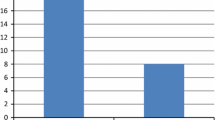Abstract
Background and aims
The widespread use of meshes for the repair of incisional hernia is currently followed by an increasing number of re-operations. The incidence of incisional hernia recurrence after mesh repair varies between 3 and 32%. The problem of mesh failure and options for another surgical intervention seem rather unattended.
Methods
We present our experience of 77 re-operations after previous mesh repair that were performed between 1995 and 2004 out of a total of 1,070 operations for incisional hernia. The retrospective analysis focused on recurrence in relation to location, material of the previous mesh repair and the surgical procedure to resolve the problem.
Results
The locations of the preceding meshes were epifascial as onlays (n=23), retromuscular as sublays (n=46), within the defect as inlays (n=6) or intraperitoneally (n=2). The direction of the incision was vertical medial (n=41) or horizontal crossing the linea semilunaris (n=36). Recurrences after median incisional hernia mesh repair mainly occurred at the cranial border of the mesh subxiphoidal. Except for two patients, all recurrences manifested at the margin of the enclosed mesh.
Conclusions
Re-operation after previous mesh repair is a surgical challenge. The type of revision procedure has to consider the position and material of the previous mesh. In our clinic recurrences, heavyweight polypropylene meshes were mostly treated with mesh exchange and lightweight polypropylene meshes could be treated by extension with a second mesh. In contrast to suture techniques, deficient mesh repairs are more evidently related to technical problems.

Similar content being viewed by others
References
Hoer J, Lawong G, Klinge U, Schumpelick V (2002) Factors influencing the development of incisional hernia. A retrospective study of 2,983 laparotomy patients over a period of 10 years. Chirurg 73(5):474–480
Schumpelick V, Conze J, Klinge U (1996) Preperitoneal mesh-plasty in incisional hernia repair. A comparative retrospective study of 272 operated incisional hernias. Chirurg 67(10):1028–1035
Schumpelick V, Klinge U, Junge K, Stumpf M (2004) Incisional abdominal hernia: the open mesh repair. Langenbecks Arch Surg 389(1):1–5
Flum DR, Horvath K, Koepsell T (2003) Have outcomes of incisional hernia repair improved with time? A population-based analysis. Ann Surg 237(1):129–135
Jansen PL, Mertens PR, Klinge U, Schumpelick V (2004) The biology of hernia formation. Surgery 136(1):1–4
Burger JW, Luijendijk RW, Hop WC, Halm JA, Verdaasdonk EG, Jeekel J (2004) Long-term follow-up of a randomized controlled trial of suture versus mesh repair of incisional hernia. Ann Surg 240(4):578–583 (discussion 583–585)
Langer C, Neufang T, Kley C, Liersch T, Becker H (2001) Central mesh recurrence after incisional hernia repair with Marlex—are the meshes strong enough? Hernia 5(3):164–167
Schumpelick V, Nyhus L (2003) Meshes: benefits and risks. Springer, Berlin Heidelberg New York
Junge K, Klinge U, Rosch R, Mertens PR, Kirch J, Klosterhalfen B et al (2004) Decreased collagen type I/III ratio in patients with recurring hernia after implantation of alloplastic prostheses. Langenbecks Arch Surg 389(1):17–22
Conze J, Prescher A, Klinge U, Saklak M, Schumpelick V (2004) Pitfalls in retromuscular mesh repair for incisional hernia: the importance of the “fatty triangle”. Hernia 8(3):255–259
Conze J, Prescher A, Kisielinski K, Klinge U, Schumpelick V (2005) Technical consideration for subxiphoidal incisional hernia repair. Hernia 9(1):84–87
Klosterhalfen B, Junge K, Hermanns B, Klinge U (2002) Influence of implantation interval on the long-term biocompatibility of surgical mesh. Br J Surg 89(8):1043–1048
Klosterhalfen B, Klinge U, Hermanns B, Schumpelick V (2000) Pathology of traditional surgical nets for hernia repair after long-term implantation in humans. Chirurg 71(1):43–51
Klosterhalfen B, Klinge U, Schumpelick V (1998) Functional and morphological evaluation of different polypropylene-mesh modifications for abdominal wall repair. Biomaterials 19:2235–2246
LeBlanc KA, Whitaker JM (2002) Management of chronic postoperative pain following incisional hernia repair with Composix mesh: a report of two cases. Hernia 6(4):194–197
Author information
Authors and Affiliations
Corresponding author
Rights and permissions
About this article
Cite this article
Conze, J., Krones, C.J., Schumpelick, V. et al. Incisional hernia: challenge of re-operations after mesh repair. Langenbecks Arch Surg 392, 453–457 (2007). https://doi.org/10.1007/s00423-006-0065-1
Received:
Accepted:
Published:
Issue Date:
DOI: https://doi.org/10.1007/s00423-006-0065-1




